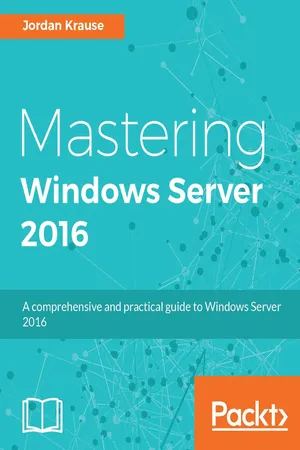
- 416 pages
- English
- ePUB (mobile friendly)
- Available on iOS & Android
Mastering Windows Server 2016
About this book
A comprehensive and practical guide to Windows Server 2016
About This Book
- In-depth coverage of new features of Windows Server 2016
- Gain the necessary skills and knowledge to design and implement Microsoft Server 2016 in enterprise environment
- Know how you can support your medium to large enterprise and leverage your experience in administering Microsoft Server 2016,
- A practical guide to administering Windows server 2016
Who This Book Is For
The book is targeted at System Administrators and IT professionals who would like to design and deploy Windows Server 2016 (physical and logical) Enterprise infrastructure. Previous experience of Windows Server operating systems and familiarity with networking concepts is assumed. System administrators who are upgrading or migrating to Windows Server 2016 would also find this book useful.
What You Will Learn
- Familiarize yourself with Windows Server 2016 ideology, the core of most datacenters running today
- New functions and benefits provided only by the new Windows Server 2016
- Get comfortable working with Nanoserver
- Secure your network with new technologies in Server 2016
- Harden your Windows Servers to help keep those bad guys out!
- Using new built-in integration for Docker with this latest release of Windows Server 2016
- Virtualize your datacenter with Hyper-V
In Detail
Windows Server 2016 is the server operating system developed by Microsoft as part of the Windows NT family of operating systems, developed concurrently with Windows 10. With Windows Server 2016, Microsoft has gotten us thinking outside of the box for what it means to be a system administration, and comes with some interesting new capabilities. These are exciting times to be or to become a server administrator!
This book covers all aspects of administration level tasks and activities required to gain expertise in Microsoft Windows Server 2016. You will begin by getting familiar and comfortable navigating around in the interface. Next, you will learn to install and manage Windows Server 2016 and discover some tips for adapting to the new server management ideology that is all about centralized monitoring and configuration.
You will deep dive into core Microsoft infrastructure technologies that the majority of companies are going to run on Server 2016. Core technologies such as Active Directory, DNS, DHCP, Certificate Services, File Services, and more. We will talk about networking in this new operating system, giving you a networking toolset that is useful for everyday troubleshooting and maintenance. Also discussed is the idea of Software Defined Networking. You will later walk through different aspects of certificate administration in Windows Server 2016. Three important and crucial areas to cover in the Remote Access role -- DirectAccess, VPN, and the Web Application Proxy -- are also covered.
You will then move into security functions and benefits that are available in Windows Server 2016. Also covered is the brand new and all-important Nano Server!
We will incorporate PowerShell as a central platform for performing many of the functions that are discussed in this book, including a chapter dedicated to the new PowerShell 5.0. Additionally, you will learn about the new built-in integration for Docker with this latest release of Windows Server 2016. The book ends with a discussion and information on virtualizing your datacenter with Hyper-V.
By the end of this book, you will have all the ammunition required to start planning for and implementing Windows Server 2016.
Style and approach
This book offers a practical and wide coverage of all features of brand new Microsoft Server 2016 along with tips on daily administration tasks.
Frequently asked questions
- Essential is ideal for learners and professionals who enjoy exploring a wide range of subjects. Access the Essential Library with 800,000+ trusted titles and best-sellers across business, personal growth, and the humanities. Includes unlimited reading time and Standard Read Aloud voice.
- Complete: Perfect for advanced learners and researchers needing full, unrestricted access. Unlock 1.4M+ books across hundreds of subjects, including academic and specialized titles. The Complete Plan also includes advanced features like Premium Read Aloud and Research Assistant.
Please note we cannot support devices running on iOS 13 and Android 7 or earlier. Learn more about using the app.
Information
Mastering Windows Server 2016
Table of Contents
Table of contents
- Mastering Windows Server 2016